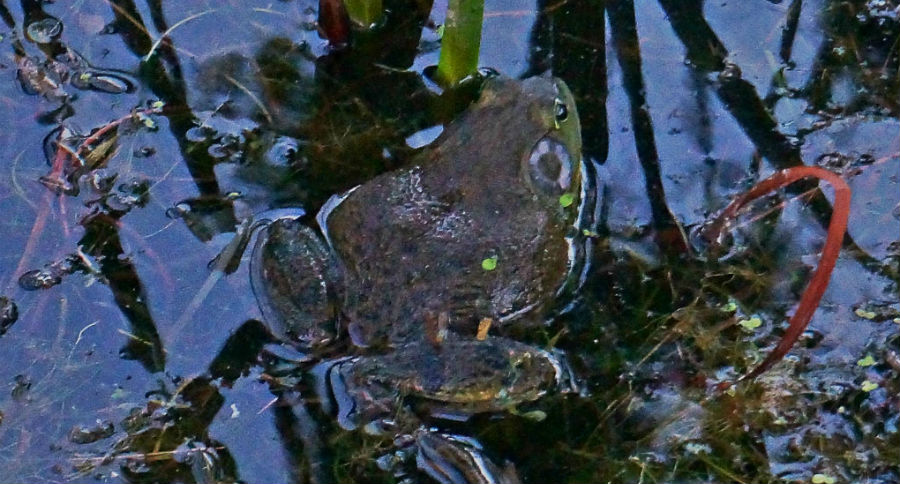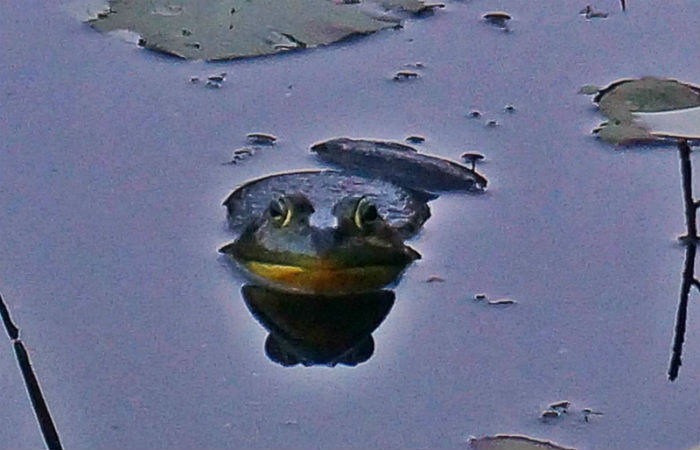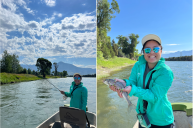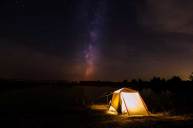Frog gigging is an awesome and unusual way to harvest some of the best tasting meat to grace your dinner plate. Here's what you'll need to get started.
One of my fondest childhood memories was of going frog gigging with my dad. On a weekend night we'd head out to a little lake where we used to camp and fish. We'd bring flashlights, a multi-prong frog spear, and a gunny sack.
We'd walk the shore of that lake in the darkness, while a chorus of deep baritone bullfrog croaking surrounded us.
My dad would have me sweep the flashlight beam slowly across the shoreline until a set of frog's eyes reflected back. He'd crouch, spear in hand, and thrust the barbed pole into a giant bullfrog hypnotized by the light.
He'd then slide the gig pole backwards in his hands until he could reach the frog. Then he'd dislodge the big frog from the spear head and drop the croaker into the gunny sack attached to his belt.
We'd bring home dozens of the large amphibians, some with hind legs as big as chicken legs, or at least it seemed. The next day my mom would sauté or bread and deep fry them, and we'd eat like kings.
I learned to love frog legs at an early age and I've always enjoyed harvesting them whenever I had the opportunity.
Getting started
We should make it clear that our quarry is the American bullfrog. The bullfrog is the big daddy of the frog world, at least in America. All other frogs are too small to bother with as far as the amount of meat they carry is concerned.
Bullfrogs primarily inhabit the East Coast, the Midwest, and the southeastern states, although they can also be found in a few western states. California reportedly has a healthy population of the slippery amphibians, and they are considered an invasive species there. They have also been introduced into several countries outside the U.S..
Hunting frogs is called 'frog gigging' or simply frogging or gigging. Before you decide that you'd like to try your hand at this mostly nocturnal sport, you need to check your state's hunting or fishing regulations to find out if there is a frogging season.
While this wasn't the case when I was growing up, today most states have seasons, bag limits, and approved methods of harvest when going after frogs.
Everyone should take time to Google Frog Gigging. You've not lived till you've watched people gigg frogs. Unbelievable pic.twitter.com/bdRdXHsm
— Andrew Staal (@drewski_staal) March 29, 2012
States also may require you to have a fishing or hunting license to pursue frogs. Tennessee, for example, requires a hunting license. Most other states require a fishing license.
Bag limits vary, depending on bullfrog populations and their status as either a desirable or invasive species. In Arkansas, for example, the daily bag limit is 18 bullfrogs. In Wisconsin, it's only five. In California there is no bag limit and you can harvest as many as you like.
Bullfrogs are big
Bullfrogs are not to be confused with any other kind of frog; they grow much bigger. While it is possible to confuse small, immature bullfrogs with the species known as green frogs, you don't want to harvest any little frogs anyway. So you should never make the mistake of confusing the two species.
Bullfrogs measure around 6-8 inches from snout to butt, and can weigh upwards of a pound-and-a-half (though most weigh under a pound). They are green with yellowish or mottled undersides. They also have large circular tympana, or eardrums, right behind their eyes.
Their hind legs measure considerably longer than their bodies when extended. Their legs give them the ability to jump some pretty impressive distances, and are the prize we're after.
They make deep, bellowing mating calls that sound like a chorus of tubas around a lake at night.
https://youtu.be/M02_dnl9zCA
Frog gigging equipment
You can go frog gigging with a bare minimum of equipment and at a cost that is practically nil. Here's the minimum of what you'll need to start:
Flashlight. You could dispense with this piece of gear and gig for bullfrogs in the daytime. But doing it at night increases your odds, as the frogs are more vocal and easier to locate then. Also, the light from a flashlight has the effect of immobilizing or hypnotizing the frogs, making your approach much less noticeable.
You don't need a super powerful light, but a water resistant flashlight comes in handy for obvious reasons. You might want to have an extra set of batteries or even a second flashlight on hand just in case.
Frog gig. You can't be a frog gigger if you don't have a frog gig. A gig is a multi-tined spear head at the end of a long pole. You can use the cheapest, three-prong barbed gig head you can buy, which is what my dad used to great effect.
They cost just two or three bucks at most any big box department store in the sporting goods section. Simply nail or screw the gig to a broom handle and you're good to go.
Or you can go all out and get a heavy duty gig head that's already attached to a telescoping pole for $20 or $30. I know what I'd prefer.
https://www.instagram.com/p/Bljw4nAHsP2/
Sack. You need something to hold the frogs you harvest. A gunny sack or potato sack will do nicely. Some folks prefer a potato sack because it drains water more easily. Carry it or tie it to your belt.
Other pieces of gear to consider include:
- Waders or muck boots, especially if you're gigging frogs from shore.
- Bug spray. Where there are frogs there are mosquitoes.
- Boat, if you choose to attack the amphibians from the water. You might combine a little night fishing with your frog gigging. If you do use a boat, a push-pole isn't a bad idea for quietly getting your boat into position close to shore.
That's really all you need.
I should also mention that I've caught frogs with a fishing pole and small lures. Bullfrogs have ravenous appetites and will strike at anything small that hovers above their heads. If you spot a bullfrog hiding in the weeds you can dangle a small fly or lure a few inches above its head and he will jump at it. I've hooked many a croaker this way.
Cleaning your catch
Clean bullfrogs by removing the hind legs with a butcher knife, cleaver, or game shears. Skin the legs similarly to how you might skin a bullhead or catfish. Use a pliers to pull the skin off, then snip the feet off with the game shears.
Don't bother with the front legs. They're too small.
Once you've got your frog legs cleaned and rinsed, cover them with salted water and allow them to firm up in the fridge for a little while.
Then, you've got any number of cooking options. Lots of folks like to use a deep fryer. Simply use an egg wash and bread crumb mixture to prepare them like you would most fish. Deep fried frog legs are fantastic.
Or you can sauté them in butter with a little lemon and parsley.
One of my favorite ways to prepare them is to sauté them in a honey brandy sauce. I once had this dish in a restaurant and fell in love with it. As soon as I got home I began trying to replicate the honey brandy sauce until I got it right. It's my go-to frog leg recipe.
If you're looking for something unusual to do on a warm summer night, why not give frog gigging a try?
It is a truly simple outdoor pursuit that yields big dividends. You'll be hard pressed to find a better meat or a more fun night-time outdoor activity.
Like what you see here? Experience more articles and photographs about the great outdoors at the Facebook page, Stumpjack Outdoors.
NEXT: MY EXPERIENCE WITH STURGEON SPEARING ON LAKE WINNEBAGO
WATCH






